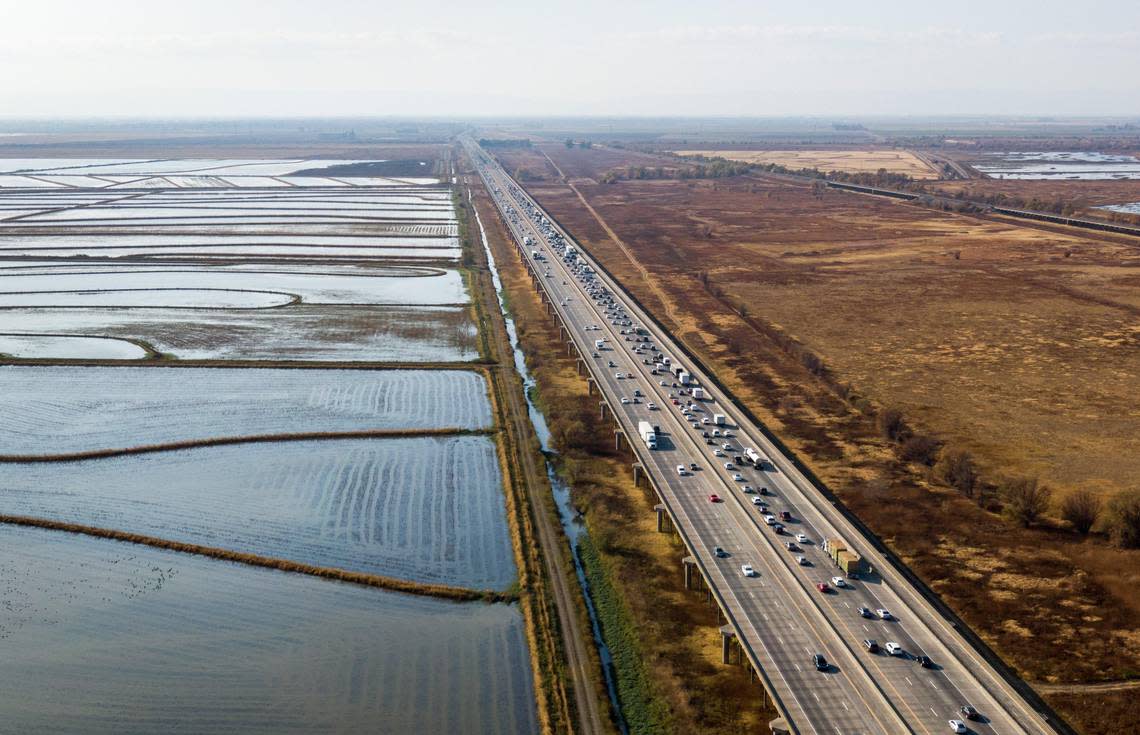If Gov. Newsom is a ‘climate champion’ why are his own people fixed on polluting? | Opinion

- Oops!Something went wrong.Please try again later.
Congestion and vehicle emissions have gotten so bad that Sacramento region’s transportation planner is banking on some big freeway changes as our part in the battle against climate change. Gov. Gavin Newsom and his California Department of Transportation, however, are not cooperating.
Interstates 5 and 80, along with Highway 50, will eventually need two express lanes at rush hour in key stretches requiring either three passengers or single-occupancy vehicles paying the first-ever tolls in the region.
Opinion
As Caltrans is studying options for an additional lane on I-80 between Davis and downtown Sacramento, conspicuously missing is the double express lane plan advanced by the Sacramento Area Council of Governments. Lanes that move more people more quickly are essential to SACOG complying with state law to lower the region’s greenhouse gas emissions.
Why isn’t Caltrans even bothering to study the SACOG plan as it seeks to comply with state environmental law requiring the agency to analyze a “reasonable range of alternatives?” In so many words, Caltrans says that it is SACOG’s fault.
“A multiple express lane alternative was never requested by SACOG to be analyzed,” emailed Dennis Keaton, a public information officer for Caltrans local District 3.
Caltrans refusal to study the regional transportation planning agency’s express lane strategy brings into serious question whether the agency’s yet-to-be-completed environmental analysis, if challenged, complies with the California Environmental Quality Act. Ignoring the regional transportation strategy is an apparent violation of its own guidelines, which calls for consistency with local plans.
“We are basically undercutting the state of California’s climate planning,” said Stephen Wheeler, a professor of architecture and environmental design at the University of California at Davis. Speaking recently at a local panel discussion on the I-80 project, Wheeler said, “Caltrans is now basically operating as a rogue agency operating in defiance of state and local policy.”
For the Newsom administration, it sets in motion a curious conflict between itself and the Sacramento region. For all the governor’s talk about being bold on climate change, why can’t his own agency stomach what it is going to take to lower emissions when a local freeway is widened?
The region’s first toll lane test
Known as the Yolo Corridor Improvement Project, Caltrans proposes to add about 20 miles of toll lanes between Davis and downtown Sacramento on 80/50 as well as on I-80 to West El Camino Avenue. Caltrans released its draft environmental impact report on the $465 million project in November. The public comment period closes on Jan. 12.
The year before Caltrans began the environmental review process, SACOG submitted its double-express-lane proposal to a sister state agency, the California Air Resources Board. By law, SACOG must develop a so-called Sustainable Communities Strategy that demonstrates to CARB how the region intends to lower its greenhouse gas emissions in 2035 by 19% compared to 2005. That will require a lot more growing inside communities rather than outside and far more efficient transportation strategies like express lanes.
CARB barely approved SACOG’s 2020 plan, which only calculated an 18.5% reduction in emissions as opposed to the required 19%. CARB gave the region a pass by allowing SACOG to round the 18.5% to the higher number.
The SACOG proposal for this 80 project calls for one express lane to be for high-occupancy vehicles at all times and the other only at peak hours. The agency called for “dynamic pricing” for the solo motorists willing to pay for a faster ride, with yet-to-be-determined tolls varying based on the level of congestion. The toll revenues would help pay for transit and other transportation projects to further improve the region’s mobility.
“We see these toll lanes as the high-speed internet of the region’s freeway system,” said James Corless, SACOG’s executive director. On the highest-used freeways such as I-5 between downtown and the Sacramento International Airport and the Yolo Corridor, two express lanes are needed to guarantee higher speeds. “We need to encourage more efficient use of the lanes.”
Caltrans’ refusal to analyze two express lanes on I-80 puts SACOG in a difficult position with one of its key transportation partners. “We have to be very thoughtful about providing transportation alternatives in these corridors,” Corless said. At least Corless has some company. The Yolo County Transportation District in 2022 also wrote to Caltrans urging that a multiple-lane alternative be studied. It was ignored as well.
One noted expert in California environmental law says that Caltrans may be vulnerable to legal challenges under the California Environmental Quality Act (CEQA) by leaving out SACOG’s two-lane alternative.
“Longstanding CEQA precedent requires the lead agency under CEQA to include a broad (if not exhaustive) range of reasonably feasible project alternatives,” said Professor Richard Frank, director of the California Environmental Law & Policy Center at the UC Davis Law School. “I think a reviewing court could well find Caltrans’ CEQA alternatives analysis defective for not including the SACOG option.”
Caltrans risks losing $86 million in federal dollars for this project if it doesn’t have an approved project by September, a Caltrans official previously told the Bee. But now it simply has no other choice to blow this deadline.
The department must follow its guidelines and reopen the analysis process to review the SACOG plan for two express lanes during peak hours for the Yolo Corridor Project. Corless and SACOG must stick up for the region’s plan and politely request the same. So should the governor and his team.
Newsom’s next climate change trip shouldn’t be to China; it should be to 703 B Street in Marysville — headquarters of Caltrans District 3. Sacramentans are going to have to get accustomed to changes such as toll lanes and carpooling if we are to do our part to lower greenhouse gas emissions. But we can’t do the right thing if Newsom doesn’t get the memo to his transportation department.

